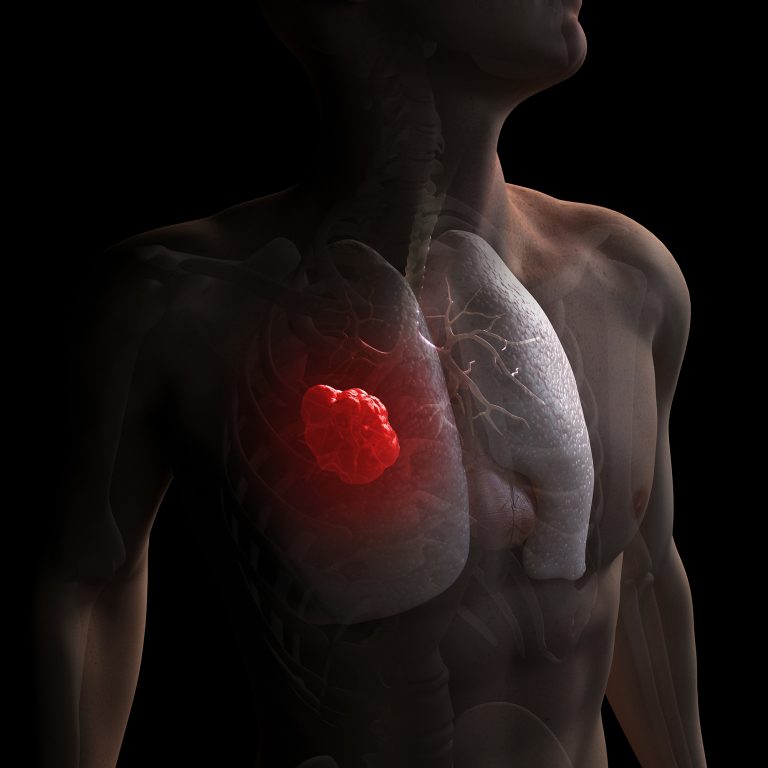
A new approach to mapping single cells in early-stage lung cancer tumors reveals details about tumor development and possible new therapeutic targets. The study, from researchers at the University of Texas MD Anderson Cancer Center, was published today in Cancer Discovery.
By studying the geospatial architecture of individual cell populations of lung adenocarcinoma (LUAD), the team discovered a diverse microenvironment with extensive interactions between cancer cells, normal cells, and immune cells that regulate early lung cancer development. They observed that some cancer cells express higher levels of CD24, an immune checkpoint protein that could have a role as a new immunotherapy target for lung cancer treatment.
“Our study is the first to look at this through spatial mapping of multi-region normal tissues and the tumor itself at the single-cell level,” said co-senior author Humam Kadara, PhD. “This work provides new insights into how lung adenocarcinomas evolve from a particular region in the lung and already has pointed us to a promising new therapeutic target in CD24.”
To construct the map, the researchers performed single-cell RNA sequencing of 186,916 cells from 5 early-stage LUADs and 14 multi-region normal lung tissues located within a known proximity from the cancerous tumors. They discovered that cellular lineages, states, and transcriptomic features geospatially evolve across normal regions to LUADs.
While normal lung epithelial cells were distinct from the tumor cells, those closer to the tumor shared more similarities with the tumor cells compared to distant normal tissue. These signatures also were evident in precancerous lesions compared to normal lung tissue, suggesting the data may be useful in identifying markers for early detection or prevention.
Similar trends were observed when looking at immune cells. With increasing proximity to the tumor, the researchers observed a shift in immune cell composition and signals toward a pro-tumor, immunosuppressive environment. For example, T regulatory cell (Tregs) increase in surrounding normal cells within a close proximity to LUAD. Earlier studies have shown that immunosuppressive T regulatory cells are crucial for immune evasion in lung cancer.
The reverse is true for cytotoxic CD8+ T cells, antigen-presenting macrophages, and inflammatory dendritic cells (DCs)—all key factors providing immunity against lung tumors. The absence of these cells in LUAD suggests that the microenvironment warrants further investigation in the evolution from normal to LUAD development, possibly signaling potential targets for immune-based therapy.
In smokers, high plasma cell fractions were found among LUADs from smokers compared with non-smokers, suggesting that plasma cells may also play important roles in the pathogenesis of smoking-associated LUAD and its microenvironment.
By examining interactions between the tumor and immune microenvironment, the researchers discovered that CD24, highly expressed in lung cancer cells, is a pivotal point of interaction between cancer cells and immune cells. In independent cohorts of early-stage lung cancers, CD24 expression correlated with poor clinical outcomes and shortened survival. Further, blocking CD24 significantly reduced the growth of lung cancers in animal models.
“This high-resolution spatial mapping generated a much more complete picture of lung cancer than was previously available, and we believe this will be a valuable resource to the research community,” said co-senior author Linghua Wang, MD, PhD. “We now have a greater understanding of the tremendous heterogeneity of diverse cell populations within the tumor immune microenvironment and of the importance of tumor-microenvironment interactions in regulating cancer progression.”
The researchers plan on studying how different cancer drivers, such as smoking or genetic mutations, influence the tumor immune microenvironment and its role in the evolution of early-stage lung cancer.













